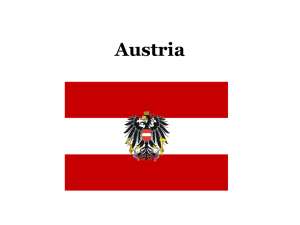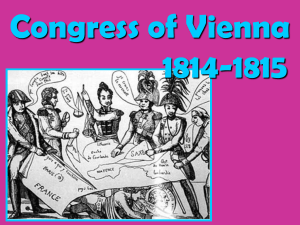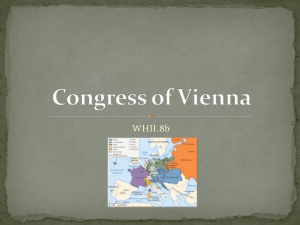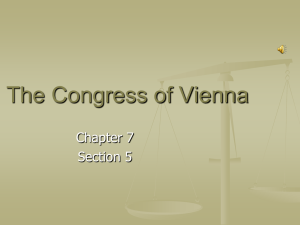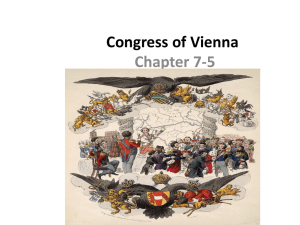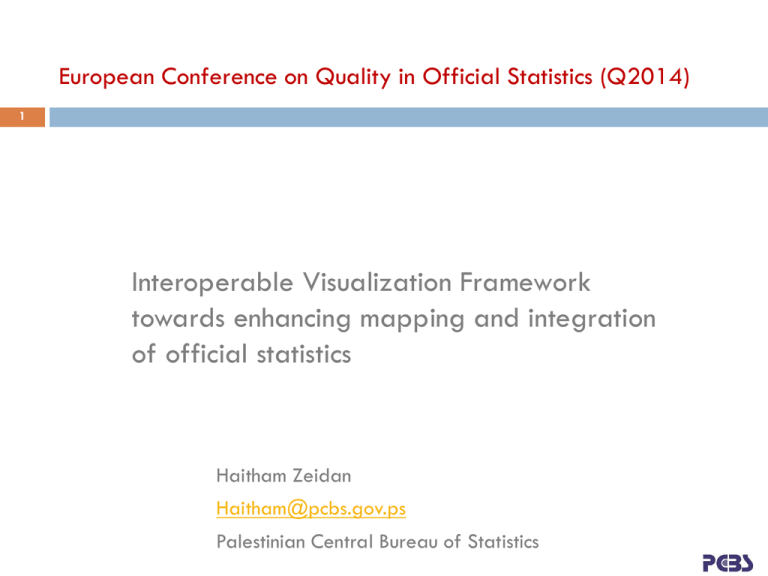
European Conference on Quality in Official Statistics (Q2014)
1
Interoperable Visualization Framework
towards enhancing mapping and integration
of official statistics
Haitham Zeidan
Haitham@pcbs.gov.ps
Palestinian Central Bureau of Statistics
Contents
2
Objectives
Methodology:
Data preparation
Data Analysis
Database Schema
Data Mapping Algorithm
Importing and Mapping Indicators
Data Visualization
Experimental Results
Conclusion and Future Work
European Conference on Quality in Official Statistics (Q2014)- 2-5 June, 2014, Vienna, Austria
Objectives
3
The objective of this study is to introduce a new interoperable visual
analytics framework for:
Collecting, mapping, grouping, and integrating heterogeneous data and
statistical indicators into a common schema.
Mapping indicators by building mapping algorithm using hamming distance,
edit distance and ontology.
Enhancing presentation of official statistics based on visual analytical
approach that combines both data analysis and interactive visualization.
European Conference on Quality in Official Statistics (Q2014)- 2-5 June, 2014, Vienna, Austria
Objectives
4
European Conference on Quality in Official Statistics (Q2014)- 2-5 June, 2014, Vienna, Austria
Methodology
5
To achieve the objectives of this research and build the Visual Analytics
Framework, we collected statistical data indicators (MDGS) from different
surveys and sources.
Data Preparation: Collecting Data/Indicators, we select data from different
subjects (sectors).
Data Analysis: Defining indicators, units and subgroups, Linking indicators,
units and subgroups to form I-U-S combinations, Categorizing I-U-S
combinations under various classifications.
Entity-Relationship (ER) Diagram and Database Schema
Implementation of Data Mapping Algorithm
Indicators Mapping
Visualization
Experimental Results and Algorithm Accuracy
European Conference on Quality in Official Statistics (Q2014)- 2-5 June, 2014, Vienna, Austria
Data Preparation
6
We focus in our study on Millennium Development Goals (MDGs) indicators
Statistical data and indicators were included in different sectors and sub
sectors like economy, education, environment, health, information and
communication, nutrition, population and women.
Many interviews with the managers of Palestinian Central Bureau of Statistics
(PCBS) departments and divisions were conducted to know the structure of
the indicators, subgroups and units and to help us in building the final
schema.
European Conference on Quality in Official Statistics (Q2014)- 2-5 June, 2014, Vienna, Austria
Data Analysis
7
After defining and preparing indicators, we defined the unit for each
indicator and associated each indicator with the correct unit, then we defined
the subgroups for each indicator. A subgroup is a subset within a sample or
population identified by some common dimension such as sex, age or
location.
Multidimensional ‘Cube’ of data
European Conference on Quality in Official Statistics (Q2014)- 2-5 June, 2014, Vienna, Austria
Entity-Relationship (ER) Diagram
8
European Conference on Quality in Official Statistics (Q2014)- 2-5 June, 2014, Vienna, Austria
Database Schema
9
Database Schema Snapshot
European Conference on Quality in Official Statistics (Q2014)- 2-5 June, 2014, Vienna, Austria
Data Mapping Algorithm
10
After building our schema, we build mapping
algorithm in C# using hamming distance and
edit (Levenshtein) distance, and by adding
ontology, edit distance can be considered a
generalization of the Hamming distance, which
is used for strings of the same length and only
considers substitution edits
European Conference on Quality in Official Statistics (Q2014)- 2-5 June, 2014, Vienna, Austria
String Comparator Metrics
11
Hamming Distance:
The Hamming distance between two strings of equal length is the number of
positions at which the corresponding symbols are different. In another way, it
measures the minimum number of substitutions required to change one string
into the other, or the minimum number of errors that could have transformed
one string into the other.
For instance, the Hamming distance between "toned" and "roses" is 3,
between “1011101” and “1001001” is 2, and between
“2173896” and “2233796” is 3.
For binary strings "a" and "b", the Hamming distance is equal to the number
of ones (population count) in a XOR b
European Conference on Quality in Official Statistics (Q2014)- 2-5 June, 2014, Vienna, Austria
String Comparator Metrics
12
Edit (Levenshtein) Distance :
Edit distance is a way of quantifying how dissimilar two strings (e.g., words)
are to one another by counting the minimum number of operations required to
transform one string into the other.
Edit distance can be calculated using dynamic programming (Navarro &
Raffinot 2002). Dynamic programming is a method of solving a large
problem by regarding the problem as the sum of the solution to its
recursively solved sub problems
European Conference on Quality in Official Statistics (Q2014)- 2-5 June, 2014, Vienna, Austria
String Comparator Metrics
13
Edit (Levenshtein) Distance (Cont.):
To compute the edit distance ed(x,y) between strings x and y, a matrix
M1...m+1,1...n+1 is constructed where Mi,j is the minimum number of edit operations
needed to match x1...i to y1...j. Each matrix element Mi,j is calculated as per
Equation 1, where
if a = b and 1 otherwise. The matrix element M1,1
is the edit distance between two empty strings.
Equation 1: Edit distance ed(x,y) between strings x and y.
European Conference on Quality in Official Statistics (Q2014)- 2-5 June, 2014, Vienna, Austria
String Comparator Metrics
14
Edit (Levenshtein) Distance (Cont.):
An example to calculate the edit distance between the strings “Kitten" and
“Sitting". The edit distance between these strings given as Mm+1,n+1 is 3.
Kitten
Sitting
1st step: kitten sitten (substitution)
2nd step: sittensittin (substitution)
3rd step: sittinsitting (insertion)
European Conference on Quality in Official Statistics (Q2014)- 2-5 June, 2014, Vienna, Austria
String Comparator Metrics
15
Edit (Levenshtein) Distance (Cont.):
Table (1) is an example of the matrix produced to calculate the edit distance
between the strings "DFGDGBDEGGAB" and "DGGGDGBDEFGAB". The edit
distance between these strings given as Mm+1,n+1 is 3.
D
G
G
G
D
G
B
D
E
F
G
A
B
0
1
2
3
4
5
6
7
8
9
10
11
12
13
D
1
0
1
2
3
4
5
6
7
8
9
10
11
12
F
2
1
1
2
3
4
5
6
7
8
8
9
10
11
G
3
2
1
1
2
3
4
5
6
7
8
8
9
10
D
4
3
2
2
2
2
3
4
5
6
7
8
9
10
G
5
4
3
2
2
3
2
3
4
5
6
7
8
9
B
6
5
4
3
3
3
3
2
3
4
5
6
7
8
D
7
6
5
4
4
3
4
3
2
3
4
5
6
7
E
8
7
6
5
5
4
4
4
3
2
3
4
5
6
G
9
8
7
6
5
5
4
5
4
3
3
3
4
5
G
10
9
8
7
6
6
5
5
5
4
4
3
4
5
A
11
10
9
8
7
7
6
6
6
5
5
4
3
4
B
12
11
10
9
8
8
7
6
7
6
6
5
4
3
European Conference on Quality in Official Statistics (Q2014)- 2-5 June, 2014, Vienna, Austria
Ontology
16
An ontology typically provides a vocabulary that describes a domain of
interest and a specification of the meaning of terms used in the vocabulary
Ontology matching is a solution to the semantic heterogeneity problem.
It finds correspondences between semantically related entities of ontologies.
These correspondences can be used for various tasks, such as ontology
merging, query answering, or data translation.
European Conference on Quality in Official Statistics (Q2014)- 2-5 June, 2014, Vienna, Austria
Indicators Mapping
17
Example of Importing and Mapping "Growth rate of GDP /person employed" Indicator.
European Conference on Quality in Official Statistics (Q2014)- 2-5 June, 2014, Vienna, Austria
Indicators Mapping
18
Example of Importing and Mapping "Urbanization Level" Indicator without Ontology.
European Conference on Quality in Official Statistics (Q2014)- 2-5 June, 2014, Vienna, Austria
Indicators Mapping with Ontology
19
Example of Importing and Mapping "Urbanization Level" Indicator with Ontology.
European Conference on Quality in Official Statistics (Q2014)- 2-5 June, 2014, Vienna, Austria
Sectors, Classes, and Units Mapping
20
Importing % Unit without using Ontology.
European Conference on Quality in Official Statistics (Q2014)- 2-5 June, 2014, Vienna, Austria
Sectors, Classes, and Units Mapping
21
Importing % Unit using Ontology.
European Conference on Quality in Official Statistics (Q2014)- 2-5 June, 2014, Vienna, Austria
Data Visualization
22
European Conference on Quality in Official Statistics (Q2014)- 2-5 June, 2014, Vienna, Austria
Experimental Results
23
To test and evaluate the accuracy of the mapping algorithm in
practice, we performed some experiments on many indicators, the
indicators chosen from different countries since each country
indicators different from others in the name of the indicators, units
and subgroups, this will help us to test the algorithm accuracy.
European Conference on Quality in Official Statistics (Q2014)- 2-5 June, 2014, Vienna, Austria
Mapping Results without Ontology
24
Algorithm Indicators, Units and Subgroups Mapping Accuracy without Ontology.
European Conference on Quality in Official Statistics (Q2014)- 2-5 June, 2014, Vienna, Austria
Mapping Results with Ontology
25
Algorithm Indicators, Units and Subgroups Mapping Accuracy with Ontology.
European Conference on Quality in Official Statistics (Q2014)- 2-5 June, 2014, Vienna, Austria
Accuracy of the algorithm according to our
results without ontology and with ontology
26
Algorithm Indicators, Units and Subgroups Mapping Accuracy
with Ontology and without Ontology.
European Conference on Quality in Official Statistics (Q2014)- 2-5 June, 2014, Vienna, Austria
Conclusion and Future Work
27
This research aimed to introduce a new interoperable visual analytics
framework for Collecting, mapping, processing, and disseminating statistical
data based on common schema, heterogeneous data from different data
sources integrated using the created algorithm
we suggested new mapping algorithm based on hamming distance, edit
distance and ontology, using our algorithm we enhanced integration and
mapping of statistical data indicators from different sources.
We tested the accuracy of the algorithm, experimental results shown high
accuracy of mapping for the algorithm by adding the ontology to the
algorithm. the accuracy of the algorithm when importing and mapping
indicators without ontology was 67% and with ontology the accuracy was
89%, for units mapping the accuracy was 82% without ontology and 95%
with ontology, and for subgroups the accuracy was 78% without ontology
and 100% with ontology.
European Conference on Quality in Official Statistics (Q2014)- 2-5 June, 2014, Vienna, Austria
Conclusion and Future Work
28
Future work includes:
To focus more on data mapping using ontology.
Extending our mapping algorithm to handle more sophisticated mappings
between ontologies (i.e., non 1-1 mappings),
Also to focus more on collecting data from different sources since we focused
as a case study on importing data from different excel sources (files),
Future work includes also improving collaboration with visual analytics
framework.
Additional methods are required to support the users in finding good views
on the data and in determining appropriate visualization techniques.
We have to consider the 3D visualization of uncertain graph structures with
uncertain attributes, which we think is a formidable challenge.
European Conference on Quality in Official Statistics (Q2014)- 2-5 June, 2014, Vienna, Austria
European Conference on Quality in Official Statistics (Q2014)
29
Thanks
Interoperable Visualization Framework
towards enhancing mapping and integration
of official statistics
Haitham Zeidan
Haitham@pcbs.gov.ps
Palestinian Central Bureau of Statistics

